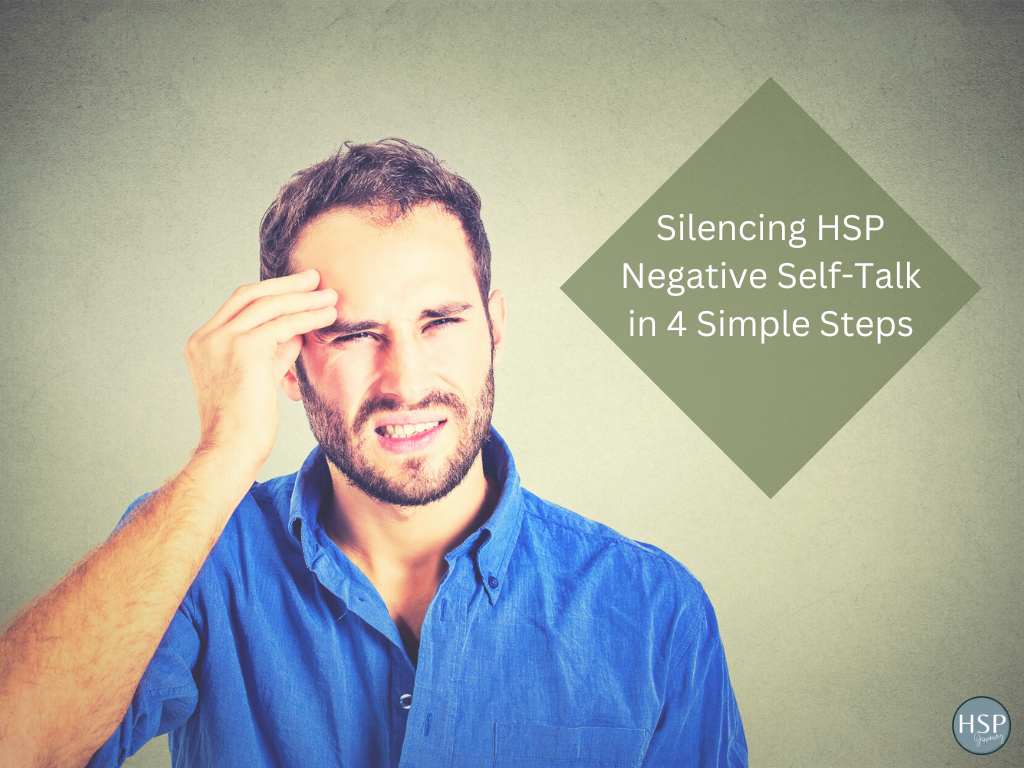As an extremely self-aware highly sensitive person (HSP), I have realized that over the years, I have spent an exorbitant amount of time listening to my internal negative self-talk and even more time analyzing why my inner-critic speaks so loudly, where it came from, when did that voice start, and how the blazes do I shut it up. Silencing HSP negative self-talk is no easy task, to say the least.
If your inner-critic is taking up space in your head, I’d like to save you some time and energy by suggesting you skip the analysis part. Not just because HSPs tend to be overthinkers, but because when it comes down to it, all of our negative thinking, limiting beliefs, and unhealthy habits stem from ‘mislearning’ and faulty programming during our early development years. So rather than focus on the ‘how and why’ we have an inner-critic, let’s get right to action. In this article, I’ll aim to share with you four simple steps to assist you in silencing HSP negative self-talk.

Table of Contents
The Goal: Silencing Negative Self-Talk
Making any kind of positive change in yourself is no different than any other goal you have set and achieved in your life. In your youth, perhaps you had a goal to buy cool new sneakers or concert tickets, so you saved your allowance and found jobs in your neighborhood. As an adult, you set goals for your education, finances, career, or set aside time to learn to play an instrument or speak a new language.
“A goal without a plan is just a wish.”
Antoine de Saint-Exupéry
Let’s establish The Goal: “My goal is to stop my negative self-talk.” Silencing negative self-talk is hard! Now that I’ve said it, you’ll know that what you’re up against isn’t easy, but I do believe you can change because I’ve seen it over and over again with my clients. However you want to phrase it, I invite you to say it out loud, write it down, and put it somewhere you’ll see it several times a day (screen saver, post it notes around the house, etc). Keeping your goal in the forefront of your mind will help you stay focused on carrying out the plan.
The Plan that worked for me (and I still use when I’m triggered) is outlined below in four simple steps. You might choose to work each step for a week, or stay with each step until you feel you’ve mastered it, or go through all the steps consecutively right away.
This is intended to be a framework for your experimentation. Change something that doesn’t work for you. I mostly want to encourage you to be patient with yourself (and your inner-critic). You’ve been in a relationship with it for however long, so it’s going to take some time and patience to change that relationship!
Step #1 — Notice when your inner-critic is taking over your thoughts.
This step might sound obvious, but if your negative self-talk has been going on for a while, chances are you have gotten so used to it, you don’t realize when it’s talking at you. You might even think that you’ve learned how to tune it out, but if you’re reading this article, that’s probably not the case.
To help me become aware of my inner-critic, I set an alarm for various times of the day to pause and reflect on what my recent thoughts had been – then I’d note them in my journal. Sometimes, I noticed that my thoughts had been positive and self-loving – which gave me a boost in self-confidence! In any case, taking an inventory of my recent thoughts helped me to quickly identify if and when my inner-critic was active.
Step #2 — Acknowledge your inner-critic whenever it shows up.
This step is one I had to refine a number of times because when I realized how often my negative self-talk occurred, all I wanted to do was beat myself up for beating myself up. How does that make sense?
“Don’t beat yourself up for beating yourself up.”
So the key to the second step is simply to ACKNOWLEDGE when that inner-voice starts talking. You can do this by thinking or saying out loud, “Oh hey. I see you there.” Or “Yup, I can hear you.” By acknowledging your inner-critic in this way (without judgment or emotion), it creates a psychological distance, making it easier for you see it for what it is and then manage it accordingly.
Step #3 — Have an honest conversation with your inner-critic.
I have a friend who says that her inner-critic is really the voice of her disapproving mother and every time she hears it, she flicks at her shoulder as if swatting away a fly. This approach might work for some, but as an HSP, I have found that a gentler approach works better for me; specifically, one that respects and honors every part of myself, including my inner-critic.
When I notice that silencing HSP negative self-talk becomes harder because my inner-critic is driving my thoughts, after acknowledging it, I invite it to have a conversation. It goes something like this: “Hey, I understand that at some point in my life, you may have been instrumental in protecting me, and I thank you for that. But I need you to take a break, okay? I’ll check in with you later, but for right now, I need you to be quiet. Can you do that?”
Whatever the conversation sounds like for you, keep in mind that the inner-critic is a part of the ego and that means there may be some resistance, which is why I take a gentle approach and keep the conversation going indefinitely versus trying to ignore it, severe the relationship or treat my inner-critic with hostility.
“The secret of change is to focus all of your energy, not on fighting the old,
Socrates
but on building the new.”
ENERGY SKILLS WORKBOOK
FOR HIGHLY SENSITIVE/EMPATH ADULTS
Can you imagine feeling more balanced, confident, and at ease? Are you ready to learn the skills to help shift your energy and emotions?
If you’re an HSP/empath who’s ready to feel more comfortable in your “sensitive skin”, this digital workbook is for you.
With over 100 pages of engaging, uplifting material — including 20 energy-shifting exercises and how-to videos — the Energy Skills Workbook for HSP/Empath Adults will help you develop awareness and adaptability, resulting in increased self-confidence and mental/physical wellness.
Step #4 —Have fun with it.
When I thought about my inner-critic, I realized what a killjoy it had been my entire life. It never had anything funny to say. It never made me laugh or take myself less seriously. And it didn’t ever make me become a better person (even though I sometimes thought that was its underlying mission).
If I wanted to shift my inner-critic’s power and hold over me, I knew I had to bring some fun and humor into the relationship. Here are just a few ways I continue to do that in my life today:
Take a look at the many free and inexpensive downloadable resources from Jeannette Folan’s Empath Diary website.
Personify your inner-critic with an inanimate object-and silence HSP negative self-talk.
To make the psychological distance more tangible, try picking out an object to represent your inner-critic. It could be a drawing of what you think your inner-critic looks like, or maybe a prickly cactus or a figurine. I have a custom-made doll I call “Stinky.” He wears a sideways baseball cap and a mischievous smirk. When he’s filling my head with negative talk, I give him a time out.
Take things a step further and give your inner-critic a theme song. My go-to’s include “King of Anything” by Sarah Bareilles, “Roar” by Katy Perry and “Hit the Road Jack” by Ray Charles (an oldie but a goodie). Any time I sense my inner-critic looking for an opening, I sing. It makes me laugh, immediately diffusing the negative thoughts.

Dress up your inner-critic as a cheerleader.
I routinely imagine Stinky in a cheerleader uniform (with pom-pons) and encourage him to do a cheer for me. “You can do it, yes you can! I know because I’m your #1 fan!” This works for my self-critic because I’m still keeping it engaged, which disarms the resistance we talked about earlier. I’ve learned over time that Stinky really needs to be included in some way, otherwise he has a temper tantrum.
As silly as some of these strategies may sound, I encourage you to give them a try. When you work on silencing your inner-critic and focus on transforming the inner-critic from a judgmental bully to an entertaining supporter (or at the very least, a neutral bystander), you can find success in silencing HSP negative self-talk.
With a little practice, I am confident that you’ll discover how effective awareness, acknowledgement, honesty and humor can be in rebuilding your relationship with your inner-critic–and keeping them in check.
Be sensitive, be free
*This post contains affiliate links and I will be compensated if you make a purchase after clicking on my links*






[…] The self-compassion test helps you recognize these patterns of self-criticism. When you notice negative self-talk, pause and take a deep breath. Ask yourself if you’d speak to a friend this […]